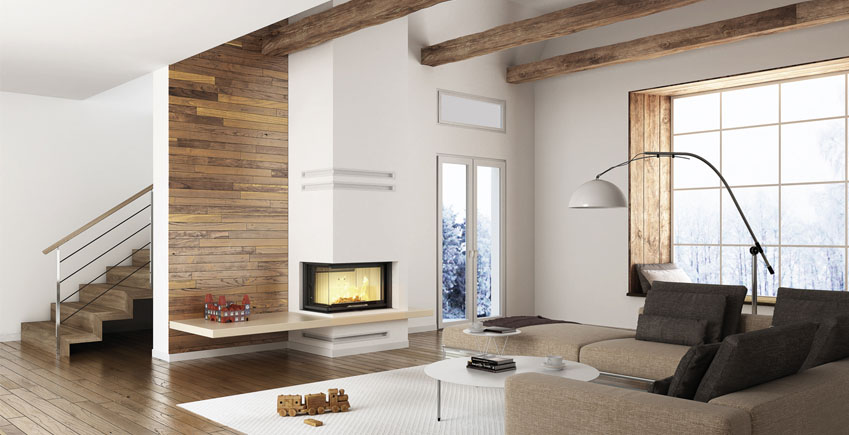
Will a mantelpiece fireplace heat a house?
The biggest advantage of a fireplace with a water jacket is the ability to connect to a central heating system or an underfloor heating system. Unlike standard (classic fireplaces), the heat from the exhaust gases does not go to the chimney, but raises the temperature of the heating medium (i.e. water) to the selected level (e.g. 95℃). A fireplace with a water jacket has both aesthetic and practical functions. It enables effective and energy-saving heating not only of the room in which it is located, but also of other rooms (with which it is connected). The heat accumulated and then distributed throughout the rooms allows you to quickly raise the air temperature to a comfortable level. But can a fireplace effectively heat the entire house?
How does a mantelpiece fireplace work?
The principle of operation of a fireplace equipped with a water jacket is slightly different than that of standard models. This is due to the presence of a water jacket in the form of a tank or a pipe filled with air. This solution means that fireplaces of this type achieve very high efficiency, which in many cases significantly exceeds 80%.
When burning fuel (e.g. seasonal wood), hot exhaust gases gradually heat the water in the tank or pipe. This solution means that hot water can be distributed through pipes to radiators located only in the room where the fireplace is located or to other rooms. Nothing prevents hot water from reaching rooms throughout the house.
Additional information about how a fireplace with a water jacket works
Is there a chance that the water in the tank or pipe will boil and thus damage the fireplace or central heating system (or underfloor heating system)?
These and similar questions are often asked by people who are considering purchasing a fireplace with a water jacket. The answer is simple. NO. Why? Primarily due to the safety system, which prevents water from boiling even if the fireplace is used for a long time.
Fireplace with a water jacket – is it worth investing in?
The purchase and installation of a fireplace with a water jacket allows you to significantly reduce heating costs. The amount of savings depends not only on the size of the house, but also on the method of its insulation, the type of fireplace (its power and efficiency), the type of fuel and other factors.
In some cases, heating the house with a fireplace allows you to reduce annual heating expenses by up to 40%. For this reason, purchasing and installing a fireplace equipped with a water jacket is a good investment that allows you to save relatively large amounts of money.
A modern fireplace with a water jacket manufactured by a reputable company with many years of experience is distinguished by its reliability and virtually maintenance-free operation. Even with frequent use, maintenance is kept to a minimum. So, is it worth investing in a fireplace with a water jacket? Definitely yes.
Will a fireplace with a water jacket heat the house? Yes, but how to choose the right one?
Modern fireplaces equipped with a water jacket are suitable for both open and closed systems. Additionally, they are adapted for heat recovery. In addition to the appearance and type of the fireplace (one or two-sided view of the fire), technical parameters are also extremely important. The first is the heating load range. The next one is the nominal power. Both parameters are given by manufacturers in kilowatts (abbreviated as kW). For spacious houses, the best choice will be fireplaces with a heating load range from approximately 10.5 kW to approximately 27 kW. In turn, the nominal power should be approximately 21 kW.
In smaller, medium-sized and small houses, furnaces with a lower heating load, e.g. 8 kW - 21 kW or 9.5 kW - 24 kW, are sufficient for heating. In turn, the sufficient nominal power is 16 kW or 19 kW.
What else should you pay attention to when choosing a fireplace with a water jacket?
Another key parameter that should be given special attention is the capacity of the water jacket expressed in dm³. The larger it is, the more effective the fireplace will be, and therefore the more efficient the heating of the rooms.
Fireplaces with a water jacket intended for large houses have a jacket capacity of 65 dm³. In turn, models intended for smaller houses are equipped with a water jacket with a capacity of approximately 45 dm³.
Eco-friendly fireplaces with a water jacket guarantee efficient fuel combustion (the best is seasoned wood from deciduous trees such as birch, beech and hornbeam. The fuel moisture should be in the range from 12% to 20%). In addition, they are distinguished by extremely low CO and pollen emissions. This combination makes them completely safe to use.
If you want to limit maintenance work to an absolute minimum, it is worth choosing a fireplace with a so-called clean glass system. In everyday use, this means not only the ability to observe a beautiful view of the fire, but also the maximum reduction in the frequency of cleaning the fireplace.
The most important advantages of fireplaces with a water jacket
Modern fireplaces equipped with a water jacket are characterized by trouble-free operation, regardless of the intensity of use.
Correct use (in accordance with the manufacturer's recommendations) guarantees a long service life. Moreover, fireplaces are ecological, safe, clean and, above all, easy to use.
Security systems (including regulation of the water temperature in the jacket) operate automatically, without user intervention. This solution makes them aesthetic and functional living room equipment that can effectively heat the entire house.

